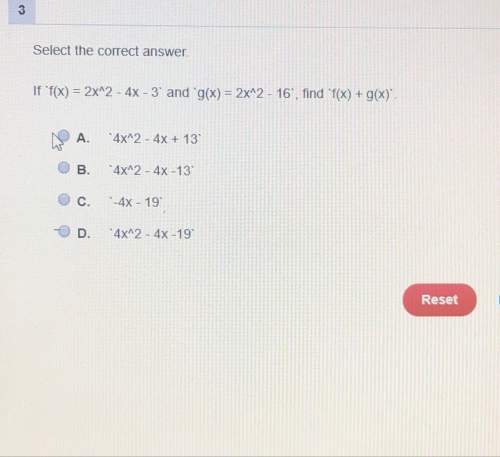
Mathematics, 17.07.2019 02:30 kkstone
Which statement explains why △abc is congruent to △a′b′c′ ? you can map △abc onto △a′b′c′ reflecting it across the line y = x and rotating it 90° counterclockwise about the origin, which is a sequence of rigid motions. you can map △abc onto △a′b′c′ by reflecting it across the x-axis and then across the y-axis, which is a sequence of rigid motions. you can map △abc onto △a′b′c′ by translating it 2 units up and reflecting it across the y-axis, which is a sequence of rigid motions. you can map △abc onto △a′b′c′ by translating it 6 units left and reflecting it over the x-axis, which is a sequence of rigid motions. two triangles on the coordinate plane. triangle a b c has vertex a at 1 comma negative 3, vertex b at 5 comma 3, and vertex c at 4 comma negative 1. triangle a prime b prime c prime has vertex a prime at negative 5 comma 3, vertex b prime at negative 1 comma negative 3, and vertex c prime at negative 2 comma 1.

Answers: 1
Another question on Mathematics



Mathematics, 22.06.2019 02:00
The statement tan theta= -12/5, csc theta=-13/12, and the terminal point determained by theta is in quadrant two
Answers: 3

Mathematics, 22.06.2019 03:00
Let f(x) = 1/x^2 (a) use the definition of the derivatve to find f'(x). (b) find the equation of the tangent line at x=2
Answers: 2
You know the right answer?
Which statement explains why △abc is congruent to △a′b′c′ ? you can map △abc onto △a′b′c′ reflectin...
Questions

Mathematics, 19.11.2020 23:40

English, 19.11.2020 23:40

History, 19.11.2020 23:40

History, 19.11.2020 23:40

Mathematics, 19.11.2020 23:40

Computers and Technology, 19.11.2020 23:40


Mathematics, 19.11.2020 23:40


Mathematics, 19.11.2020 23:40


Mathematics, 19.11.2020 23:40



Mathematics, 19.11.2020 23:40




English, 19.11.2020 23:40




